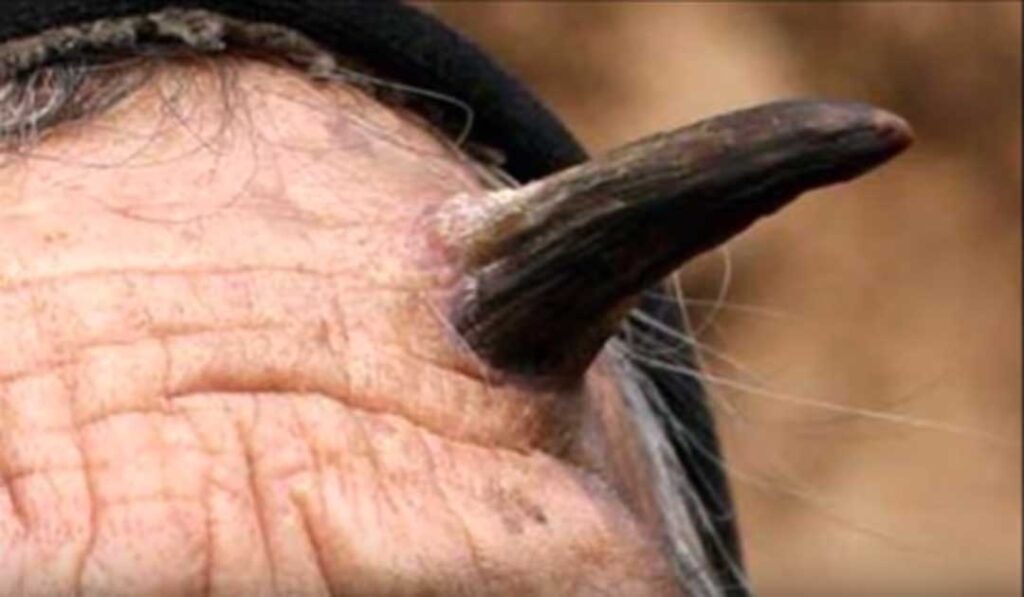

A sebaceous horn, popularly known as Devil’s Horn, grew from an old Indian man’s head after an injury.
74-year-old Shyam Lal Yadav from Rahli village in Sagar district in Madhya Pradesh, India, suffered from a rare condition that caused what resembles an animal’s horn to grow from his head. It is thought that this visually striking abnormality began growing after a head injury several years ago. The man has recently had it removed.
The doctors at the hospital said the horn-like mound started forming on his skin just after a head injury several years ago and they watched it grow bigger over time. And in an India Today article it says Shyam Lal Yadav started “cutting bits off” by himself and finally got it removed at Sagar’s Bhagyoday Tirth hospital.
Horny Devils
Doctor Vishal Gajbhiye from the hospital said that Shyam Lal suffers from a ‘sebaceous horn’ condition and that the horn-like mound was removed in an operation following an X-ray. It had to first be established how deep its roots were to make sure that attempting to remove it did not endanger Lal Yadav’s life, or threaten to cause any permanent damage. Dr Gajbhiye also said that a study of this rare case would be published in the International Journal of Surgery.
While the world’s media are today calling this condition ‘Devil’s Horn’ it was only five years ago Liang Xiuzhen, 87, of China’s Sichuan Province noticed something resembling a black mole growing on her head that grew into the shape of a large horn which caused her to become known in her village as the “unicorn woman”. A Cosmopolitan article at the time said that in 2014 “it broke” and another larger ‘horn’ replaced it at an incredible 13cm long and the sufferer said it “bleeds from time to time.”

87-year-old Liang Xiuzhen from Sichuan, China had a five inch HORN growing out of her head. (Youtube Screenshot)
Origins Of Human Horns
Historically, the earliest descriptions of cutaneous or sebaceous horns are generally associated with the work of London surgeon Everard Home in 1791, but he noted earlier 16 th and 17 th century works including the Danish anatomist Thomas Bartholin in 1670. This EMedicine article explains that the modern medical term cornu cutaneum) was once “ cornu cutaneum of Rokitansky, after the German pathologist Baron Carl von Rokitansky who revolutionized pathological anatomy.
According to the World Journal of Oncology (WJO) these growths are described as uncommon lesions consisting of keratotic material resembling that of an animal horn. The growths can arise from benign, premalignant or malignant epidermal lesions, and while most cases of cornu cutaneum are small and benign, the example in the headlines today is much larger than the norm.
The WJO study looked at eleven patients with cutaneous horns between 2000 and January 2004 and from clinical, pathological and treatment details a lot was learned about their frequency distribution. Surgical resection was carried out on eight male and three female patients, with a median age of 57 years, with lesions on their ears, hands or scalps. There were two cases of squamous cell carcinoma, and one case of basal cell carcinoma, but the other 8 cases were benign.
What Triggers Devil’s Horn In Some Humans?
While cutaneous horns take all sorts of shapes and sizes there seems to be no argument that the trigger is the Sun. A highly-graphical EJManager paper photographically illustrates the horn of a 77 year old woman with what is described as “a large horn” of 3 years. This paper says that while the cause of her cutaneous horn is still unknown, it is believed that “exposure to radiation” triggered the condition which is further evidenced by an increasing rate of cases occurring in areas that are exposed to sunlight.
Word of advice. If you waken up one morning and find an old sunburnt patch on your scalp has grown slightly, then maybe you too are growing a cutaneous horn. If so, among your treatment options are wide surgical excisions with careful histological examinations to assess the growth’s malignancy and according to SkinSight.Com, if the lesion is benign, no further treatment may be needed. However, if your horn is found to be precancerous your physician may first freeze the lesion with liquid nitrogen then scrape and burn (curettage and electrodesiccation) it.
Bury Your Horny Head At Your Peril
Now, we humans are really good at finding lumps and bumps and treating them with a quick course of “burying one’s heads in the sand.” And while that might work for some time with feet and other covered patches of skin, you will not get away with this when it comes to cutaneous horns, which you cannot hide with hats. Try as you may, you will ultimately end up like Madame Dimache, an early nineteenth century Parisian woman who grew a horn for a period of six years. By the time Dimache was in her early 70s the growth stood 20 cm (about 8 inches) from her forehead.
Madame Dimache’s second horn growth, that she grew for seven years before it was removed, was donated to the Mütter Museum collection in the 1940s and you can see this dried specimen on the Museum website, but be warned, it really is not a museum visit for the feint hearted. You will all now unquestionably have a look – but I did warn you!
